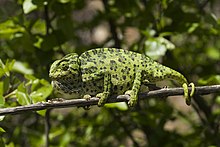| Acrodonta Temporal range: Early Cretaceous- present,
| |
|---|---|

| |
| Common chameleon, Chamaeleo chamaeleon | |

| |
| Common Agama Agama agama | |
| Scientific classification | |
| Domain: | Eukaryota |
| Kingdom: | Animalia |
| Phylum: | Chordata |
| Class: | Reptilia |
| Order: | Squamata |
| Suborder: | Iguania |
| Clade: | Chamaeleontiformes |
| Clade: | Acrodonta Cope, 1864 |
| Subclades | |
Acrodonta are a subclade of iguanian squamates consisting almost entirely of Old World taxa. Extant representation include the families Chamaeleonidae (chameleons) and Agamidae (dragon lizards), with at least over 500 species described. A fossil genus, Gueragama, was found in Brazil, making it the only known American representative of the group.[1]
The group is eponymously named from their acrodont dentition, whereby the teeth are consolidated with the summit of the alveolar ridge of the jaw without sockets.[2] There are, however, other animals that have acrodont dentition such as tuataras.[3]
- ^ Simões, Tiago R.; Wilner, Everton; Caldwell, Michael W.; Weinschütz, Luiz C.; Kellner, Alexander W. A. (26 August 2015). "A stem acrodontan lizard in the Cretaceous of Brazil revises early lizard evolution in Gondwana". Nature Communications. 6: 8149. Bibcode:2015NatCo...6.8149S. doi:10.1038/ncomms9149. PMC 4560825. PMID 26306778.
- ^ Plough, F.H.; Janis, C.M.; Heiser, J.B. (2002). Vertebrate Life (6th ed.). Prentice Hall. ISBN 0-13-041248-1.
- ^ Edmund, A. G. (1969). "Dentition". In Gans, C. (ed.). Biology of the Reptilia: Morphology A. Vol. 1. pp. 117–200. ISBN 9780122746017. Retrieved 16 August 2017.